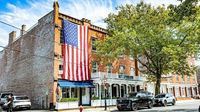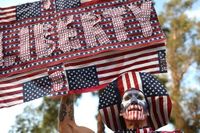On the first weekend of September 2025, the streets, restaurants, and neighborhoods of America’s cities bore witness to a labor movement in flux—celebrating its storied past, grappling with present threats, and confronting the future with renewed urgency. From the historic Pullman neighborhood in Chicago to the affluent enclaves of Long Island, union members, activists, and everyday workers marked Labor Day with parades, protests, and a call for solidarity that echoed through the corridors of power and privilege alike.
In Chicago, the heartland of American labor history, union members gathered on September 6 for the annual Labor Day Parade, a vibrant display of unity and pride that wound its way through the Far South Side’s Pullman district. According to WGN, the festivities honored unions spanning every industry—from teachers and nurses to plumbers and bricklayers—and paid special tribute to the city’s blue-collar roots. “Chicago is a town of working class folks. It’s the hometown of the American Labor Movement,” declared Bob Reiter, President of the Chicago Federation of Labor, as families and workers marched together, banners flying high.
The parade’s route was more than symbolic; it passed by the A. Philip Randolph Pullman Porter Museum, a site commemorating the 100th anniversary of the Brotherhood of Sleeping Car Porters and Maids. As Dr. David Peterson, president of the museum, reminded attendees, this was America’s first and only Black labor union to be chartered under the American Federation of Labor—a milestone that underscored the intersection of racial and economic justice. “This is the 100-year anniversary of the brotherhood of sleeping car porters and maids, which was America’s first and only Black labor union, to receive a charter under the American Federation of Labor,” Peterson said.
But the day was not just about celebration. As Patrick McCarthy of Plumbers Local 130 put it, “We’re not celebrating what we have today, we’re celebrating the people who brought us here from yesterday. There’s a lot of people that put a lot of effort, gave their lives to give us a five-day work week. That’s what Labor Day means to me.” The message was clear: the rights and benefits enjoyed by today’s workers were hard-won, and the struggle is far from over.
After the parade, the Pullman community turned its attention to honoring Edward Sadlowski, a former union activist whose legacy of advocacy remains a touchstone for many. The festival in his name was a reminder that the fight for labor rights is ongoing, evolving with each new challenge.
That same weekend, the spirit of protest took on a bolder, more confrontational form on Long Island. On August 30, a group of about ten demonstrators stormed The American Hotel in Sag Harbor, disrupting diners with chants of “Tax the rich!” as part of the Workers Over Billionaires National Day of Action. According to Newsday, the coalition Planet Over Profit—a youth-led direct action group—organized the protest to spotlight the stark wealth inequality on Long Island and across the country. “With these actions, we hope to shine a light on how billionaires are very real people who live in our communities, who make decisions that harm our communities,” said Eren Ileri, a core organizer with the group.
The demonstrators, escorted out by staff but not charged by police, made their point directly to some of the region’s wealthiest residents. Their grievances ranged from the injustice of immigration enforcement to the political influence of the affluent. “We want to build a movement, a movement of people who say enough is enough, and we’re willing to disrupt business as usual,” Ileri explained, vowing more direct actions in the days ahead.
Yet not everyone viewed the tactics favorably. Robert Fonti, chair of the Suffolk County Alliance of Chambers, cautioned that while Labor Day is about honoring workers, protests targeting wealth could inadvertently harm small businesses and the workers who rely on them. “Supporting fair wages and good jobs goes hand-in-hand with keeping small businesses strong—because both are essential to thriving communities,” Fonti told Newsday.
Vincent Vertuccio, a spokesman for Our Revolution, a nonprofit founded by Senator Bernie Sanders, defended the disruptive approach. “I don’t think it’s unreasonable that those folks should have to endure a couple of moments of discomfort to understand what both their lifestyles and their political and financial decisions are inflicting on the rest of the country,” Vertuccio said. He noted that protest, by its nature, is rarely universally popular. “If everybody likes your protests and thinks that you were super great and respectful, you probably aren’t protesting anything at all.”
Experts like Timothy Gorman, associate professor of sociology at Montclair State University, put the moment in historical context. Disruptive protest, he pointed out, has long been part of the social movement playbook—whether during the Civil Rights era or the AIDS crisis. “You can call attention to your cause. You can shake things up,” Gorman told Newsday. However, he cautioned that lasting change requires more than disruption; it demands a broad strategy and engagement with lawmakers and institutions.
Meanwhile, a storm was brewing at the national level. On September 7, the Communist Party USA Labor Commission issued a stark warning: the Trump administration’s cancellation of collective bargaining rights for over 1.3 million government workers constituted “the largest act of union busting in U.S. history.” According to the commission, approximately 84 percent of public and civil service workers lost their right to collectively bargain due to executive orders. The administration’s actions, which included firing tens of thousands of federal workers, rounding up migrant families, and deploying troops in cities, were described as a “declaration of open class war on the entire working class.”
The report drew comparisons to Ronald Reagan’s 1981 firing of striking air traffic controllers, but argued that the current assault was even more aggressive and far-reaching. Union density, already below 10 percent—and under 5 percent in the private sector—has continued to decline, leaving workers increasingly vulnerable. The commission called for militant action, including boycotts, strikes, civil disobedience, and a national day of union solidarity, insisting that “labor must talk in the only language Big Business understands: the language of economic power.”
Despite the gravity of the crisis, the labor movement’s response has been mixed. While some unions have rallied, others have opted for a quieter approach, hoping to avoid further confrontation. The commission urged a more unified, confrontational strategy, combining legal action with mass protest and grassroots organizing. “Mass public pressure must be combined with shop floor organizing and bringing as many workers into the fold as possible,” the statement read, underscoring the need for solidarity in the face of mounting challenges.
As Labor Day 2025 fades into memory, the American labor movement stands at a crossroads—buoyed by its history, tested by present adversity, and propelled by a new generation of activists determined to shape the future. The battles of the past may have delivered the five-day work week and other hard-won gains, but the struggle for justice, dignity, and power in the workplace continues, as urgent and vital as ever.





